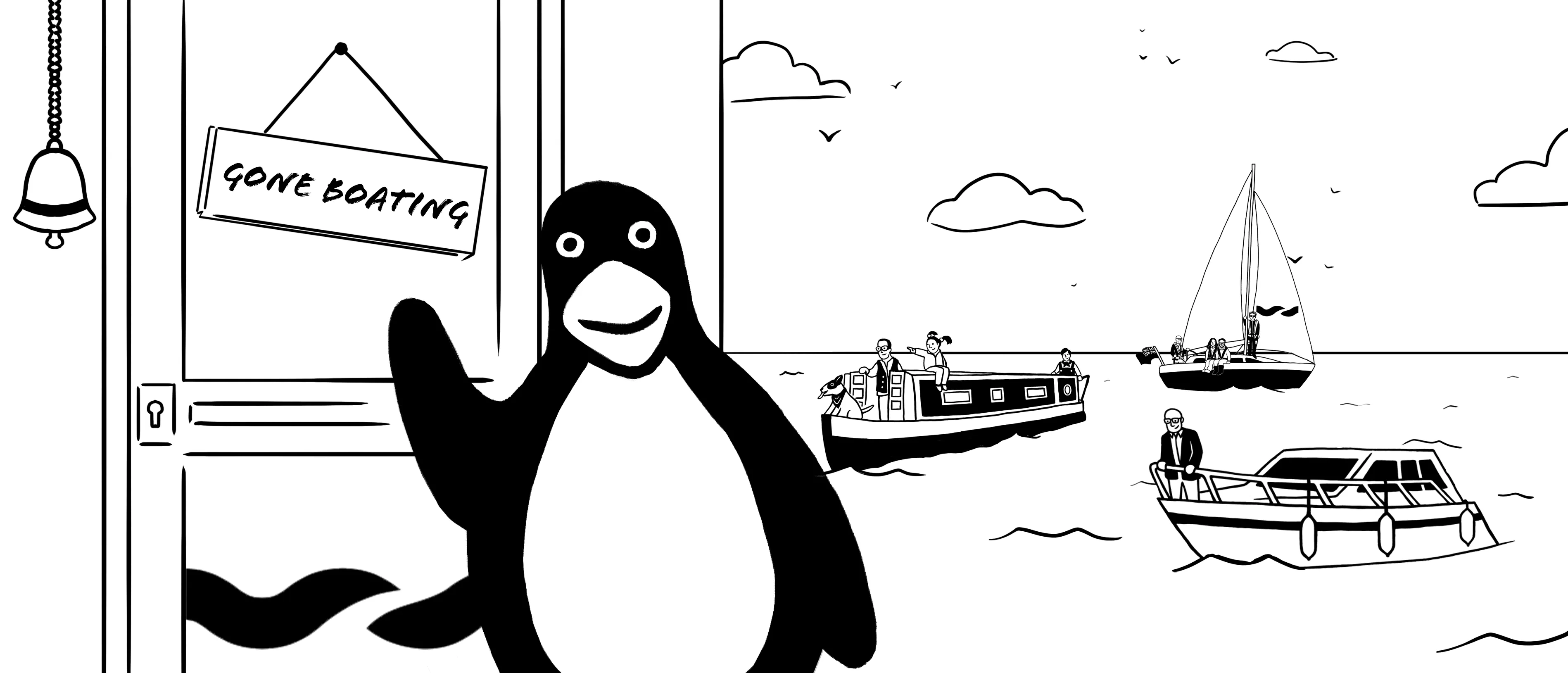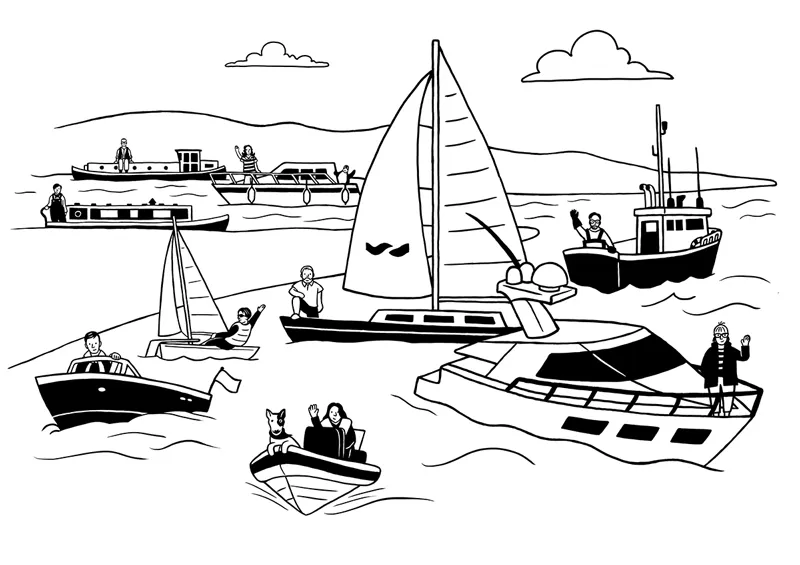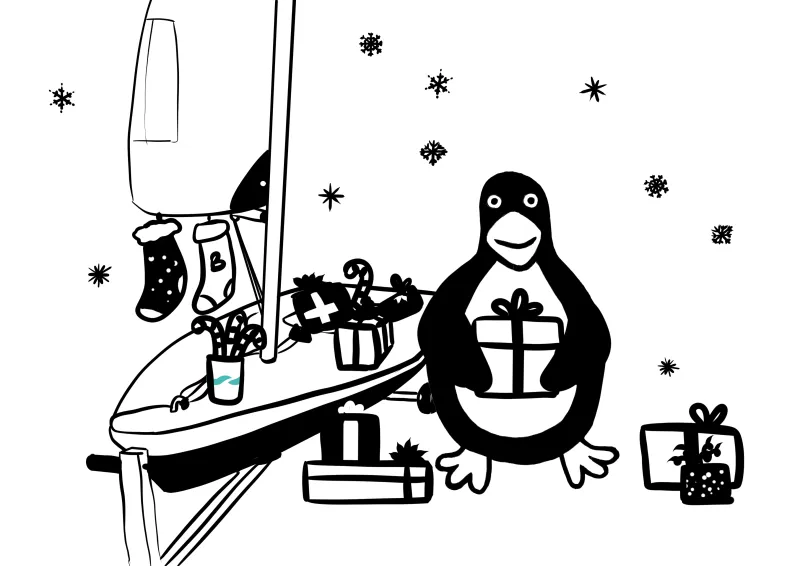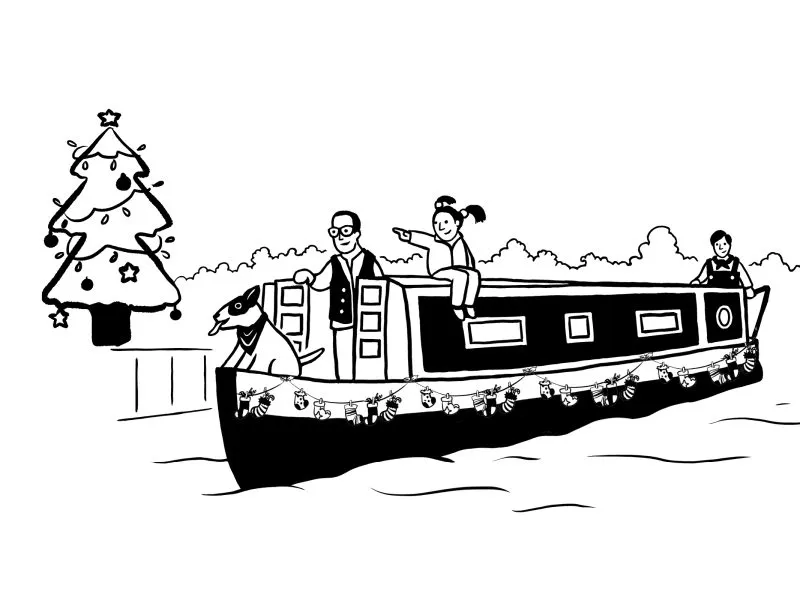A
Abaft – Towards the stern of the boat.
Abeam – At a right angle to the centre-line of the boat.
Aft – At or near the stern of the boat.
A-hull – Lashing the helm to the leeward side to ride out bad weather without the sails set.
AIS – Automatic Identification System
Amidships – The centre of the deck of the boat between the fore-and-aft.
Apparent wind – The speed and direction of the wind combined with the boat’s movement and the true wind speed and direction.
ARPA – Automatic Radar Plotting Aid.
Astern – The act of looking behind the boat when driving in reverse.
Athwartships – At right angles to the fore-and-aft line of the boat.
Azimuth – The angular distance on the horizon circle in a clockwise method, typically between a heavenly body and an observer.
B
Back – When the wind starts to shift in an anti-clockwise direction.
Back a sail – Sheeting the sail to the windward direction, so the wind fills the sail on the leeward side.
Backstay – A stay that supports the aft from the mast and prevents its forward movement.
Baggywrinkle – Rope, teased out, plaited together and wound around stays, shrouds etc. to prevent chaffing.
Ballast – Iron or lead weights, placed low in the boat or externally on the keel to provide stability.
Ballast keel – A ballast bolted to the keel to increase stability and prevent the boat from capsizing.
Batten – A light, flexible strip, fed into a batten pocket at the leech of the sail to support the roach.
Beam – The maximum breadth of the boat, or a transverse member which supports the deck On the beam, an object is at right angles to the centre-line.
Bear away – Steering the boat away from the wind.
Bearing – The direction of an object from the observer, measured in magnetic or true degrees.
Beat – To sail a zigzag course towards the wind, close-hauled on alternate tacks.
Belay -To fasten the rope around the cleat using a figure-8 knot.
Bend – Securing a sail to a spar before hoisting, or connecting two ropes with a knot.
Berth – A place occupied by a boat in harbour or marina, or sleeping quarters on a boat
Bight – A bend or loop in a rope.
Bilge – The lower, round part of the hull where water collects.
Block – A pulley in a wooden or plastic case, consisting of a sheave around which a rope runs. It is used to change the direction of pull.
Boot-topping – A narrow coloured stripe painted between the topside enamel and bottom paint.
Broach – When a boat running downwind slews broadside to the wind and heels dangerously. It is usually caused by heavy seas.
Broad reach – The point of sailing between a beam reach and a run when the wind blows over the quarter.
Bulkhead – The partitioning wall in the boat athwartship.
C
Cable – A measurement of distance equalling 0.1 sea mile, 185 metres, 200 yards.
Centre-board – A board lowered through a slot in the keel to reduce leeway.
Centre-line – Centre of the boat along the fore-and-aft line.
Chart Datum – Reference level on a chart below which the tide is unlikely to fall. The sounding features below the chart datum. The Datum level varies depending on country & area.
Claw ring – A fitting, which slips over the boom like a claw, to which the main sheet is attached after you finish reefing the sail.
Cleat – A wooden, metal or plastic fitting used to secure ropes.
Clew – The lower, aft corner of a sail where the foot and leech meet.
Close-hauled – The ability to sail closes to the wind, also known as beating
Close reach – The point of sailing between close-hauled and a beam reach, when the wind blows forward of the beam.
Close-winded – The act of a boat sailing very close to the wind.
Course – The direction in which a boat is steered, given in degrees, true, magnetic or with a compass.
Cringle – A rope loop found at either end of a line of reef points, or an eye in a sail.
D
Dead run – Sailing with the wind blowing to the aft, in line with the centre-line.
Deviation – The difference between the direction indicated by the compass needle and the magnetic meridian, caused by metal objects aboard.
Displacement (1) – The weight of water displaced by a boat is equal to the weight of the boat.
Displacement (2) – A displacement hull displaces its weight in water & is only supported by buoyancy.
Downhaul – A rope used to pull down a sail or spar.
Draft – The vertical distance from the waterline to the lowest point of the keel.
Drift – To float with the current or wind, or the distance a boat is carried by a current in a given time.
Drogue – A sea anchor thrown over the stern of a boat or liferaft to reduce drift.
Drop keel – A retractable keel which can be drawn into the hull.
DSC – Digital Selective Calling.
E
EP – Estimated Position.
EPIRB – Emergency Position Indication Radio Beacon.
ETA – Estimated Time of Arrival.
ETD – Estimated Time of Departure.
F
Fairlead – A fitting through which a line is run, allowing you to adjust the direction of the lead of the line.
Fathom – The measurement of water depth and rope lengths. 1 fathom = 6 ft = 1.83m
Fiddle – A raised border for a cabin table or a chart table, to prevent objects falling off.
Fix – The position of a boat as plotted from two or more position lines.
Forestay – The closest stay running from the masthead to the stemhead, hankering the mainsail.
Freeboard – Vertical distance between the waterline and the top of the deck.
G
Genoa – A large headsail in various sizes, which overlaps the mainsail and is hoisted in light to fresh winds on all points of sailing.
Gimbals – Two concentric rings, pivoted at right angles which keeps objects horizontal despite the boats motion.
GMDSS – Global Maritime Distress and Safety System.
GNSS – Global Navigation Satellite System.
Go about – Changing tack by turning the boat through the eye of the wind.
Gooseneck – The fitting attaching the boom to the mast, allowing it to move in all directions.
Goosewing – Booming out the headsail in a windward position by using a whisker pole to hold the sail on the opposite side to the mainsail.
GPS – Global Positioning System
Guard rail – A metal rail fitted around the boat to prevent the crew from falling overboard.
Guy – The spinnaker guy controls the steadying rope for the spar through the aft-fore position of the spinnaker pole. The foreguy holds the spinnaker pole forward.
Gybe – To change from one tack to another by turning the stern through the wind.
H
Halyard – Rope used to hoist and lower sails.
Hank – Fitting used to attach the luff of a sail to a stay.
HAT – Highest Astronomical Tide.
Hatch -An opening in the deck giving the crew access to the berth or cabin interior.
Head-to-wind – When the bows are pointing right into the wind.
Headfoil – The streamlined surround to a forestay, with a groove into which a headsail luff slides.
Heads – Toilets.
Headway – The forward movement of a boat through the water.
Heave-to – To back the jib and lash the tiller to leeward used in heavy weather to encourage the boat to lie quietly and to reduce headway.
Heel – When the boat leans over to one side.
I
IRPCS – International Regulations for Preventing Collisions at Sea.
IMO – International Maritime Organisation
ITU – International Telecommunication Union
Isobars – Lines on a weather map joining places of equal atmospheric pressure.
J
Jackstay – The line running from aft-to-fore on both sides of the boat. The jackstays allow for the clipping attachment of safety harnesses to prevent being lost at sea when falling overboard.
Jury – The temporary device for replacing damaged or lost gear.
K
Kedge – A small, light second anchor.
Keel – The main backbone of the boat to which a ballast keel is bolted or through which the centre-board passes.
Ketch – A dual-masted sailing boat with a mizzen mast slightly smaller than the main and stepped forward of the rudder stock/post.
Kicking strap – A line used to pull the boom down, to keep it horizontal, particularly on a reach or run.
L
Lanyard – A short length of line attached to an important object that you don’t want to lose. The lanyard can connect to your wrist or lifejacket.
LAT – Lowest Astronomical Tide.
Leech – The aft edge of a triangular sail, or both side edges of a square sail.
Lee Helm – The tendency of a boat to bear away from the wind.
Lee shore -The shore on which the wind is blowing.
Leeward – Away from the wind, the direction to which the wind blows.
Leeway – The sideways movement off course as a result of the wind blowing on one side of the sails and hull.
List – A boat’s more or less permanent lean to one side, owing to improper distribution of weight.
Log – An instrument for measuring a boats speed and distance travelled through the water. or to record in a book the details of a voyage.
Luff – The leading edge of a sail. To ‘luff up’ is to turn the boat’s head right into the wind.
M
Marinized engine – An auto engine which has been adapted for use in boats.
Mast step – The keel socket in which the base of the mast is located.
MCA – Maritime and Coastguard Agency.
Measured mile – A distance of one nautical mile measured between islands, buoys or onshore ranges, and marked on the chart.
Meridian – An imaginary longitudinal line circling the Earth which passes through the poles and cuts at right angles through the Equator.
Mizzen – The shorter after-mast on a ketch or yawl.
MHWN – Mean High Water Neaps.
MHWS – Mean High Water Springs.
MLWN – Mean Low Water Neaps.
MLWS – Mean Low Water Springs.
MMSI – Maritime Mobile Service Identity.
O
Outhaul – A rope used to pull out the foot of a sail.
Overall Length (LOA) – The boat’s extreme length measured from the foremost part of the bow to the aftermost part of the stern excluding bowsprit, self-steering gear etc.
P
Painter – The bow line by which a dinghy, or tender is towed or made fast.
Pan Pan – Urgency call requesting assistance.
Pay out – To let a rope put gradually.
Point of sailing -The angles of the wind allowing for the sailing of the boat. Or the boat’s course relative to its direction and the direction of the wind.
Port – The left hand side of the boat looking forward.
Port tack – A boat is on a port tack when the wind strikes the port side first and the main sail is out to starboard.
Position line/line of position – The line on charts shows the bearing of the vessel and the position where the boat mist lie. Or two positional lines providing a location fix.
Pulpit – A metal guard rail fitted at the bows of a boat to provide safety for the crew.
Pushpit – A metal guard rail fitted at the stern.
Q
Quarter – The section of the boat midway between the beam and the stern.
R
Range – The difference in water levels between the high and low tides is the range of tides. Or the distance at which you can see the light.
Reach – To sail with the wind blowing onto the beam, with all sailing points between running and close hauled.
Reef – To reduce the sail area by folding or rolling surplus material on the boom or forestay.
Reefing pennant – Strong line with which the luff or leech cringle is pulled down to the boom when reefing.
Rhumb line – The imaginary line cutting all meridians at the same angle, or the course followed by a boat sailing in a fixed direction.
Riding sail – Small sail hoisted to enable a boat to maintain steerage way during a storm.
Rigging screw – A deck fitting allowing for tensioning of the standing rigging.
Roach – The curved part of the leech of a sail which extends beyond the direct line from head to clew.
Run – To sail with the wind aft and the sails eased into the wide-out, full position.
Running rigging – All the moving lines such as sheets and halyards used in the setting and trimming of sails.
S
SAR – Search and Rescue.
SART – Search and Rescue Transponder.
Schooner – A boat with two or more masts with the mainmast aftermost.
Scuppers – Holes in the toe rail which allow water to drain off the deck.
Seacock – A valve which shuts off an underwater inlet or outlet passing through the hull.
Sea room – The room in which a boat can manoeuvre clear of land or other submerged dangers.
Security – Procedure word identifying a safety call.
Seelonce – French word for ‘radio silence’ used during distress incident.
Set – To hoist a sail, the way in which the sails fit, or the direction of a tidal current or stream.
Shackle – A metal link with a removable bolt across the open end. The shackle comes in various designs, from ‘S’ to ‘U’ shapes and more.
Sheet – The rope attached to the clew of a sail or to the boom, enabling it to be controlled or trimmed.
Shrouds – Ropes or wires usually in pairs, led from the mast to chain plates at deck level to prevent the mast falling sideways, part of the standing rigging.
Skin fitting – A through-hull fitting where there is a hole in the skin through which air or water passes. A seacock is fitted for when the hole is not in use.
Sloop – A single-masted sailing boat with one mainsail and one headsail.
SOG – Speed Over the Ground.
SOLAS – Safety of Life at Sea.
Spar – A general term used for any wood or metal pole, e.g. mast or boom, used to give shape to sails.
Spinnaker – A large, light balloon shaped sail used when reaching or running.
Splice – To join ropes or wires by unlaying the strands and interweaving them.
Spreaders – Horizontal struts attached to the mast which extend to the shrouds and help support the mast.
Stall – A sail stalls when the airflow over it breaks up causing the boat to lose its momentum.
Stanchion – Upright metal post bolted to the deck to support the guard rails.
Standing part – The part of a line not used when making a knot, or the part of a rope you use to tie around the knot.
Standing rigging – The shrouds and stays which are permanently set up and support the mast.
Starboard – Right-hand side of the boat looking forward.
Starboard tack – A boat is on a starboard tack when the wind strikes the starboard side first and the boom is out to port.
Stay – Wire or rope which supports the mast in a fore-and-aft direction, part of the standing rigging.
Steerage way – A boat has steerage way when it has sufficient speed, allowing for steering or answering the helm.
Sternway – The backward, stern-first movement of a boat.
Strop – A loop of wire or rope used to attach a block to a spar to make a sling.
T
Tack -The lower forward corner of the sail. Or to turn the boat through the wind so that it blows on the opposite side of the sails.
Tacking – Working to windward by sailing close-hauled on alternate courses so that the wind is first and one side then on the other.
Tang – A sturdy steel fitting used for attaching standing rigging to the spar or mast.
Tender – A small boat, usually inflatable models, used to ferry people and supplies from a larger boat to shore.
Tide – The vertical rise and fall of the oceans caused principally by the gravitational attraction of the moon.
Toe rail – A low strip of wood or moulding running around the edge of the deck.
Topping lift – A line from the mast head to a spar normally the boom which is used to raise it.
Track – The course a boat has made good on its travel plan. A fitting on the mast or boom onto which the slide on a sail fit. Or a fitting along which a traveller runs used to alter the tension of the sheets.
Trim – To adjust the angle of the sails with sheets so that they work most efficiently. Or to adjust the boats load and thus the fore-and-aft angle at which it floats.
True wind – The direction and speed of the wind felt when stationary at anchor or on land.
Turn buckle – Used to tighten the standing rigging.
U
Underway – A boat is underway when it is not secured to the shore, at anchor or aground.
Up haul – A line to raise something vertically for example the spinnaker pole.
V
Vang – See kicking strap.
Veer – The wind veers when it shifts in a clockwise direction. Or to pay out anchor cable or rope in a gradual controlled way.
VHF – Very High Frequency.
VMG – Velocity Made Good.
W
Wake – The disturbed water left astern of a boat.
Wavelength – Distance between radio waves.
Weather helm – A tendency of a boat to turn into wind.
Weather side – The side of the boat on which the wind is blowing.
Whisker pole – A light pole used to hold out the clew of a headsail when running.
WGS84 – World Geodetic Survey of 1984 (most common chart datum).
Winch – A winch is a mechanical device consisting usually of a metal drum turned by a handle around which a line is wound to give the crew more purchasing power when hauling taut a line.
Windage – The parts of a boat which increase drag for example rigging, spars, crew etc.
Windlass – A winch with a horizontal shaft and a vertical handle used to haul up your anchor chain.
Windward – The direction from which the wind blows toward the wind (opposite to leeward).
X, Y, Z
XTE – Cross Track Error. Perpendicular distance off track between two waypoints.
Yawl – A dual-masted boat with the mizzen stepped aft of the rudder stock / post.



